Protocols and architectures in IIoT environments

Nowadays the IoT (Internet of Things) world is increasing at an exponential speed, along with the establishment of Industry 4.0, IIoT (Industrial Internet of Things) systems are one of the main technological fields that are being promoted to enhance digital transformation. All these transformations translate into a greater use of this type of device, with the aim of streamlining and improving the production process, to increase productivity. In addition, the capabilities of these new technologies for the collection and processing of information can contribute to a process of continuous improvement of production processes. On the other hand, the adoption of these technologies may represent the emergence of new risk vectors for industrial environments, highlighting the need to know the architectures and protocols of these technologies.
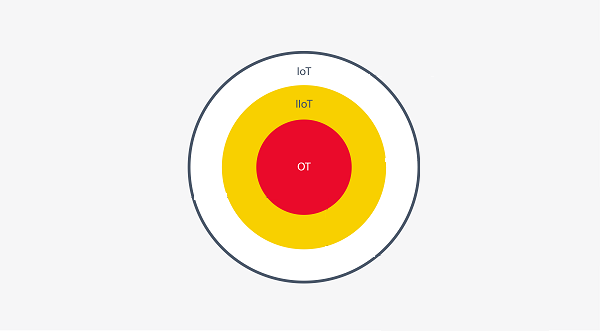
- Location of IIoT devices. Source-
Specifications
Based on the parameters set by the automation pyramid, IIoT devices must be in conjunction with field or process equipment, as these devices work together with the sensors and actuators of the various industrial devices. Within the different types of IIoT architectures that exist, we can classify them into two types:
- NBCS (Network-Based Control Systems)
- IBCS (Internet-Based Control Systems)
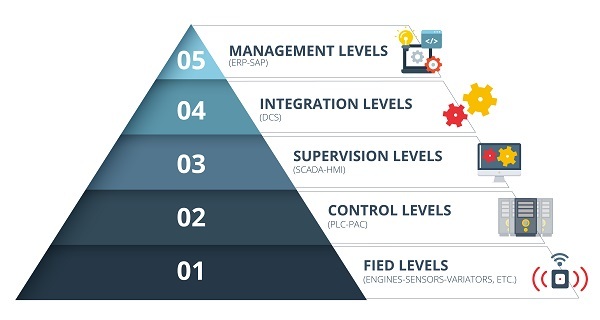
- Automation pyramid. Source-
Internet-Based Control Systems
IBCS leverage the capabilities of the internet to enable remote communications and management integration into traditional industrial control systems.
An IBCS architecture is characterized by where the controller is located and how the Internet is used. These characteristics are the main ones when determining the rest of the elements of the architecture: location and characteristics of the servers, involvement of external agents, number of controllers and scale of the process.
IBCS architectures can be encompassed in an architecture model composed of six layers, which we will detail below: Operator, Web User Interface, Internet, Local Computer, Sensors/Actuators and Process.
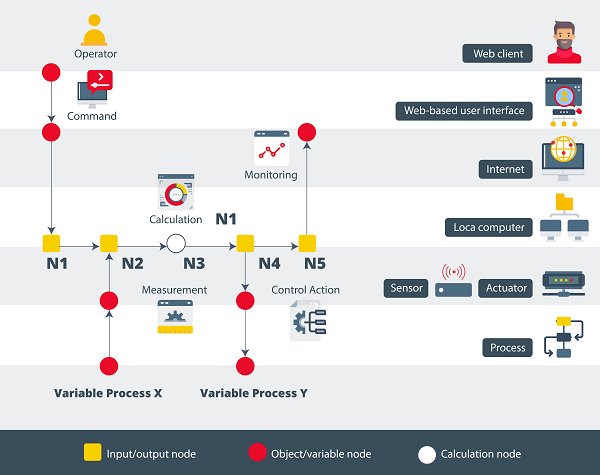
- SCBI architecture. Source-
In addition, these architectures allow different controllers to be used in industrial networks:
- Local Controller: This architecture uses a single controller locally, stability and security does not depend on the delays of the internet connection since this connection is used only for the visualization of data in production. It is the most widely used scheme today.
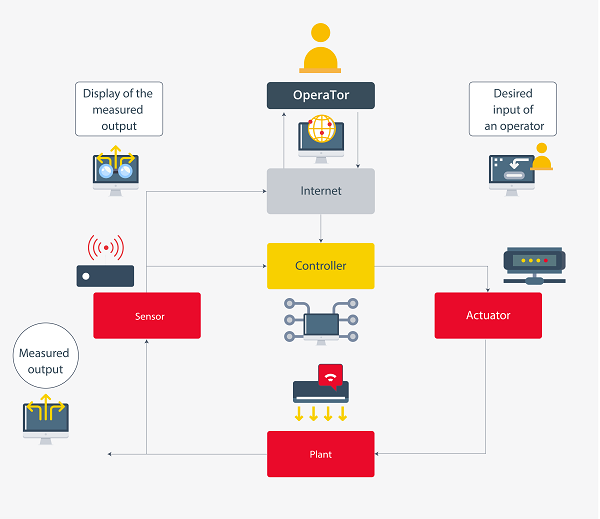
- Local controller architecture. Source-
- Remote Controller: This architecture requires extracting information from the field and sending it over the Internet. In these cases, the latency of the Internet link affects the stability of the link. This type of controller is the most economical since the controller is not located locally and therefore the company can externalize the costs by resorting to Infrastructure as a Service (IaaS) or similar. It should be noted that the implementation of this type of architecture involves the creation of remote connections for the exchange of sensitive information related to the industrial process and, in the most extreme cases, outsourcing critical parts of the process.
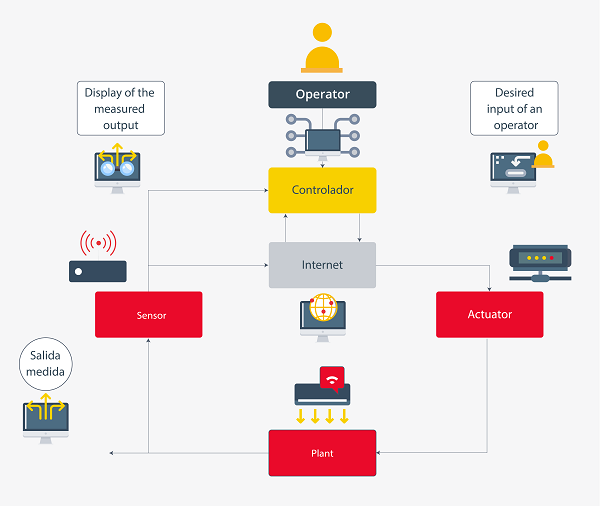
- Remote controller architecture Source-
- Bilateral Controllers: This architecture uses two controllers, one local to reduce latency and one remote to optimize link integrity. With this driver configuration, you can ensure that delays associated with the Internet do not affect production. It is the most expensive scheme, but it allows controller redundancy to be applied in favor of availability.
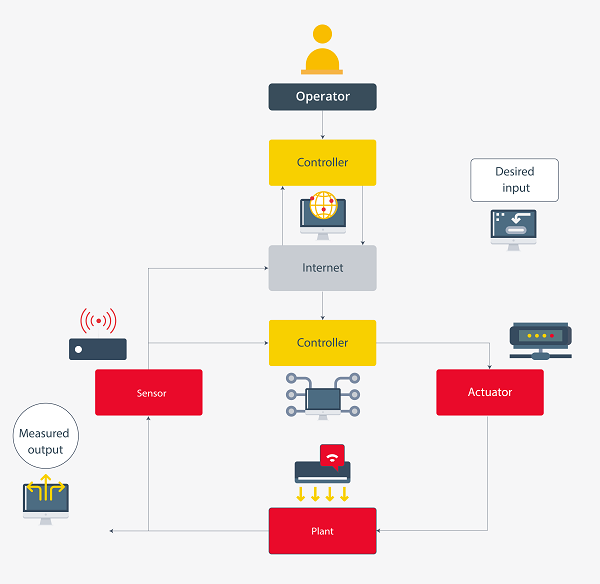
- Bilateral controller architecture. Source-
There are also other hybrid deployment possibilities, which consist of the use of edge computing, a variety of networks that eliminates the number of processes necessary to link the local network and external servers in the cloud of cloud computing architectures, achieving an improvement in latency times. This type of architecture consists of the use of servers physically located near the sensors and actuators that, in turn, would be connected to the cloud computing service. In addition to improving latency, these architectures facilitate the scalability of our architecture.
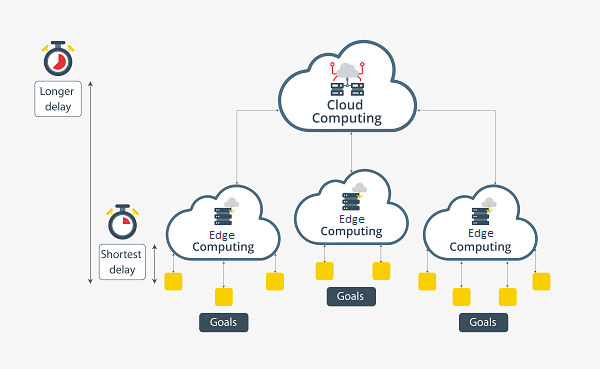
- Hybrid cloud architecture. Source-
These new architectures bring new capabilities to industrial systems (economic advantages, scalability, continuous improvement, preventive maintenance, etc.). However, they can also make an industrial system dependent on external connections or equipment, so proper management of the possible risks related to these new technologies is recommended.
IIoT Protocols
IIoT devices, the difference traditional IoT, are capable of using industry-specific standards and protocols.
The networks of these devices are made up of three main layers:
- Physical layer: This is made up of sensors and physical devices.
- Network layer: This layer is responsible for connecting the devices and acts as a gateway for the IIoT devices.
- Application layer: This is responsible for delivering the data.
Currently, there are different main technologies for implementing IIoT equipment, depending on the technology used, communications often vary significantly, this is due to several factors (obstructions between a signal and the device, the protocol used...). The IEEE 802.11x international standard defines the speed and range of signals transmitted between wireless clients.
- Mobile Networks (GSM 3G/4G/5G): This technology allows wireless connection with radio frequency waves. It also allows greater independence between devices, by being able to have multiple independent internet accesses more easily and allowing connectivity with distances from 30 to 200 km depending on the installed infrastructure, but because of this, it comes at a high cost.
- WIFI networks: This technology is one of the most widely used today as a substitute for traditional wired networks. It allows a multitude of devices to be connected to the same network, but as it has a range between 45 and 90 meters, this type of network is widely spread and is usually cheaper than GSM networks. It is also common to find it deployed together with other types of communications, due to its great flexibility and compatibility.
- Zigbee: This technology is the name of the set of high-level protocols for wireless communications. Due to its low power consumption, adaptability and security capabilities. It is one of the most widely used protocols in IIoT. Although it has a shorter range, between 10 and 100 meters, this feature can even prove to be a benefit in cases where a longer range is not necessary and can represent a larger attack surface.
- Bluetooth: This is a protocol that allows radio frequency communication. There are three classes and their range can range from 1 meter to 1 km depending on the class used. Class 1 devices can transmit up to 1 km, class 3 devices can transmit their signal up to 1 meter. Due to its use in non-industrial environments, there is a wide variety of devices that incorporate it and, therefore, it is also better known by potential attackers compared to more industrial solutions such as Zigbee.
- LoRaWan: This technology is characterized by its ability to support millions of connected devices with low consumption, it also has an application that allows you to control the different devices, it also has a range of 2 to 15 km.
- MQTT: One of the most popular protocols among those designed primarily for IIoT with security capabilities, allowing Machine to Machine (M2M) communications securely, using SSL certificates.
Conclusions
Having looked at the different types of main architectures and most commonly used protocols, it is clear that IIoT devices have different advantages during production processes.
However, these devices come with different challenges to face, as they are highly susceptible to cyberattacks. One of the great risks of this type of communication is that they are still susceptible to interception and other failures related to the loss of confidentiality of communications. For this reason, they must be implemented in a safe and responsible way, following the different widely known standards and protocols.
Opportunities
- Monitoring geographically remote devices.
- Reduction of implementation, operation and maintenance costs.
- Decrease in the consumption of energy and natural resources.
- Real-time process optimization. Improved decisions.
Challenges
- Maintain the confidentiality, integrity and availability of services.
- Ensure link performance.
- Scalability and interoperability of services.
- Compatibility with devices currently operating.
In conclusion, IIoT equipment offers us a competitive advantage by allowing us to collect and analyze in real time the data that is being generated in production systems, optimizing efficiency and decision-making within industrial processes.








